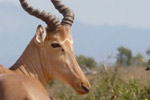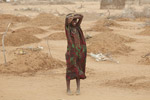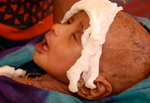Militant terrorist group Al-Shabaab funds itself, in part, through the illegal production and sale of charcoal, turning Somalia’s trees into “black gold.” Because areas of the country controlled by the group aren’t accessible to researchers, it’s difficult to determine just how many trees are cut down to fuel Al-Shabaab’s violent agenda.
So Michele Bolognesi, a researcher at the University of Twente in the Netherlands, decided to use satellite imagery to solve that problem. His team’s results were recently published in the scientific journal Energy for Sustainable Development.
As the study states, there is a critical need for data on tree loss in Somalia.
“Despite high exports of charcoal from Somalia, and its contribution to tree cover loss, consequent land degradation, and reduction of ecosystem services provided by trees, little quantitative information on tree cover loss in Somalia during the past two decades is available,” the authors write. “Moreover, Somalia is predicted to be one of the nine African countries that will face water scarcity by 2025, and therefore land degradation will worsen the water scarcity effects by increasing the population’s vulnerability to drought.”

Somalia is sparsely forested. Data on tree cover loss is available from Global Forest Watch (GFW), but is limited to areas where forest covers more than 10 percent of the ground. As such, GFW shows only 6 percent of Somalia has significant forest cover, all of it located in the far south of the country. The inset map shows satellite-detected tree cover loss from a portion of Bolognesi’s study area occurring from 2001 to 2011. Click to enlarge.
The researchers found that between 2011 and 2013, a survey area of 5,000 square kilometers (1.2 million acres) under Al-Shabaab control produced some 24,000 metric tons of charcoal, which can fetch as much 10 million Euros ($11.2 million) when sold, usually in markets on the Arabian Peninsula.
Producing that much charcoal required 372,000 cubic meters of biomass (over 13 million cubic feet) — or, in other words, 438,000 trees, amounting to 2.7 percent of the total tree coverage in the surveyed area.
Though it’s less than one percent of Somalia’s total land area, 5,000 square kilometers is still too much for one person to visually scan on their own, so the researchers used a semi-automated approach, letting algorithms pore over two years of satellite imagery in search of the telltale burnt circles that marked a charcoal production site.
“Charcoal kilns are built less than a few hundred meters from where the trees are felled to reduce transportation costs,” Bolognesi explained to mongabay in an email. “An individual kiln is used just once. Production moves on to exploit the next area with available trees.”
Bolognesi hopes that this work will lead to better monitoring of charcoal production across the entire country of Somalia, because the problem is certainly not confined to the study area. “It is likely that charcoal production takes place in a much larger area, particularly in south and central Somalia, where Al Shabaab has controlled large areas and despite declining territory, still gets major benefit from charcoal production. Charcoal is also produced in northern Somalia (current (sic) Puntland and Somaliland) as evidenced from earlier satellite studies.”

Charcoal production is rife in many parts of Africa. Here, charcoal is sold along a road in Madagascar. Photo by Rhett A. Butler.
Charcoal production in Somalia spiked sharply over the past two decades, reaching an estimated 1.2 million metric tons in 2012, up from 420,000 metric tons in 1991, the year the country’s central government collapsed. Only a fifth of the charcoal is consumed in Somalia, the rest being shipped off to the Arabian Peninsula where demand is high despite the ban on Somali charcoal exports put in place by the UN in 2012.
Of course, it’s not just Al-Shabaab looking to cash in on this Somali black gold rush. The illegal trade is apparently so robust that a report from the United Nations Environment Programme last year found that setting up roadblocks and imposing a “road tax” on charcoal shipments is another one of the militant group’s primary income streams. According to the report, Al-Shabaab can make as much as $18 million per year from just one road block.
In the end, for all the solutions Bolognesi’s work may provide to tracking and monitoring deforestation in Somalia, the true environmental impact can’t be fully assessed at this time.
“With forest degradation comes degradation of ecosystem services,” Bolognesi said. “Tree loss is affecting traditional pastoralism and likely has a negative effect on biodiversity and wildlife. However, it is impossible to effectively study such impacts in detail in the study area due to the security situation.”
Citations:
Bolognesi, M., Vrieling, A., Rembold, F., & Gadain, H. (2015). Rapid mapping and impact estimation of illegal charcoal production in southern Somalia based on WorldView-1 imagery. Energy for Sustainable Development, 25, 40-49.
Hansen, M. C., P. V. Potapov, R. Moore, M. Hancher, S. A. Turubanova, A. Tyukavina, D. Thau, S. V. Stehman, S. J. Goetz, T. R. Loveland, A. Kommareddy, A. Egorov, L. Chini, C. O. Justice, and J. R. G. Townshend. 2013. “Hansen/UMD/Google/USGS/NASA Tree Cover Loss and Gain Area.” University of Maryland, Google, USGS, and NASA. Accessed through Global Forest Watch on Mar. 05, 2015. www.globalforestwatch.org
Hansen, M. C., P. V. Potapov, R. Moore, M. Hancher, S. A. Turubanova, A. Tyukavina, D. Thau, S. V. Stehman, S. J. Goetz, T. R. Loveland, A. Kommareddy, A. Egorov, L. Chini, C. O. Justice, and J. R. G. Townshend. 2013. “Tree Cover Extent.” University of Maryland, Google, USGS, and NASA. Accessed through Global Forest Watch on Mar. 05, 2015. www.globalforestwatch.org.
}}
Related articles
|
Poor rains then floods lead to food crisis in Somalia (11/11/2014) Four years after over a quarter of a million people perished in a famine in Somalia, the East African country is again on the verge of a possible humanitarian disaster. Flooding in southern Somalia, following months of little rain, has just exacerbated an already-precarious situation according to the Food and Agricultural Organization (FAO). |
|
New report: illegal logging keeps militias and terrorist groups in business (06/30/2014) Released last week by the United Nations Environment Programme (UNEP) during the first United Nations Environment Assembly in Nairobi, Kenya, a new report found that together with other other illicit activities such as poaching, illegal deforestation is one of the top money-makers for criminal groups like Boko Haram and Al-Shabaab. |
|
Ever heard of the hirola? New survey shows world’s rarest antelope holding steady (06/18/2014) In 2008 and 2009, severe droughts killed numerous elephants, hippos and rhinos in Kenya’s Tsavo East National Park. But the tiny population of the Critically Endangered Hunter’s hartebeest or hirola (Beatragus hunteri) survived without any catastrophic consequences, a recent study has found. |
|
Somalia could face another famine due to delayed rains, insecurity (05/05/2014) Nearly a million people are in need of immediate food assistance in Somalia, where delayed rains, high food prices, and insecurity threaten a repeat of the 2011 famine that left 258,000 people dead. According to the UN’s Food Security and Nutrition Analysis Unit (FSNAU), 857,000 Somalis need immediate assistance. |
|
‘Suffering…without witnesses’: over a quarter of a million people perished in Somali famine (05/06/2013) A new report estimates that 258,000 people died in 2011 during a famine in Somalia, the worst of such events in 25 years and a number at least double the highest estimations during the crisis. Over half of the victims, around 133,000, were children five and under. The report, by the UN Food and Agricultural Organization (FAO), argues that the international community reacted too late and too little to stem the mass starvation brought on by government instability, conflict, high food prices, and failed rains, the last of which has been linked to climate change by some scientists. |
|
Working to save the mystery antelope that’s little bigger than a pet cat (photos) (04/25/2013) Little is known about the silver dik-dik (Madoqua piacentinii) population that roams the dense coastal bushlands of eastern Africa, but experts are working to learn more about the mysterious species. Weighing little more than a domestic cat, the small antelopes are found in a long, narrow coastal strip spreading across 250 kilometers (155 miles) from Somalia’s capital of Mogadishu north to the port town of Hobyo. This coastal strip is known as the Hobyo Grassland and Shrubland eco-region, according to the WWF. |




